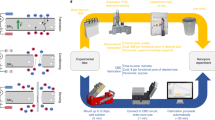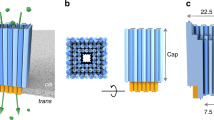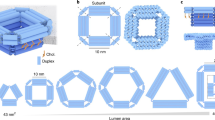Abstract
Most experiments on nanopores have concentrated on the pore-forming protein α-haemolysin (αHL)1 and on artificial pores in solid-state membranes2. While biological pores offer an atomically precise structure3 and the potential for genetic engineering4, solid-state nanopores offer durability, size and shape control5, and are also better suited for integration into wafer-scale devices. However, each system has significant limitations: αHL is difficult to integrate because it relies on delicate lipid bilayers for mechanical support, and the fabrication of solid-state nanopores with precise dimensions remains challenging. Here we show that these limitations may be overcome by inserting a single αHL pore into a solid-state nanopore. A double-stranded DNA attached to the protein pore is threaded into a solid-state nanopore by electrophoretic translocation. Protein insertion is observed in 30–40% of our attempts, and translocation of single-stranded DNA demonstrates that the hybrid nanopore remains functional. The hybrid structure offers a platform to create wafer-scale device arrays for genomic analysis, including sequencing6.
This is a preview of subscription content, access via your institution
Access options
Subscribe to this journal
Receive 12 print issues and online access
$259.00 per year
only $21.58 per issue
Buy this article
- Purchase on Springer Link
- Instant access to full article PDF
Prices may be subject to local taxes which are calculated during checkout



Similar content being viewed by others
References
Branton, D. et al. The potential and challenges of nanopore sequencing. Nature Biotechnol. 26, 1146–1153 (2008).
Dekker, C. Solid-state nanopores. Nature Nanotech. 2, 209–215 (2007).
Song, L. Z. et al. Structure of staphylococcal alpha-hemolysin, a heptameric transmembrane pore. Science 274, 1859–1866 (1996).
Bayley, H. & Jayasinghe, L. Functional engineered channels and pores. Mol. Membr. Biol. 21, 209–220 (2004).
Storm, A. J. et al. Fabrication of solid-state nanopores with single-nanometre precision. Nature Mater. 2, 537–540 (2003).
Clarke, J. et al. Continuous base identification for single-molecule nanopore DNA sequencing. Nature Nanotech. 4, 265–270 (2009).
Storm, A. J. et al. Fast DNA translocation through a solid-state nanopore. Nano Lett. 5, 1193–1197 (2005).
Wanunu, M. et al. DNA translocation governed by interactions with solid-state nanopores. Biophys. J. 95, 4716–4725 (2008)
Akeson, M. et al. Microsecond time-scale discrimination among polycytidylic acid, polyadenylic acid, and polyuridylic acid as homopolymers or as segments within single RNA molecules. Biophys. J. 77, 3227–3233 (1999).
Meller, A. et al. Rapid nanopore discrimination between single polynucleotide molecules. Proc. Natl Acad. Sci. USA 97, 1079–1084 (2000).
van den Hout, M. et al. Controlling nanopore size, shape and stability. Nanotechnology 21, 115304 (2010).
Smeets, R. M. M. et al. Noise in solid-state nanopores. Proc. Natl Acad. Sci. USA 105, 417–421 (2008).
Tabard-Cossa, V. et al. Noise analysis and reduction in solid-state nanopores. Nanotechnology 18, 305505 (2007).
White, R. J. et al. Single ion-channel recordings using glass nanopore membranes. J. Am. Chem. Soc. 129, 11766–11775 (2007).
Keyser, U. K. et al. Direct force measurements on DNA in a solid-state nanopore. Nature Phys. 2, 473–477 (2006).
Krapf, D. et al. Fabrication and characterization of nanopore-based electrodes with radii down to 2 nm. Nano Lett. 6, 105–109 (2006).
Howorka, S., Cheley, S. & Bayley, H. Sequence-specific detection of individual DNA strands using engineered nanopores. Nature Biotechnol. 19, 636–639 (2001).
Acknowledgements
This work was supported by the European Union's Seventh Framework Programme (FP7/2007-2013) under grant agreement no. 201418 (READNA), the NanoSci E+ program and the European Research Council. K.M. was supported by a Whitaker Foundation fellowship. The authors wish to thank M. Salichou for assistance with engineering of the αHL proteins.
Author information
Authors and Affiliations
Contributions
A.R.H., H.B. and C.D. designed the experiment and wrote the manuscript. D.R. and K.M made the engineered αHL pores. A.R.H and A.S. performed the measurements and analysed data.
Corresponding author
Ethics declarations
Competing interests
The authors declare no competing financial interests.
Supplementary information
Rights and permissions
About this article
Cite this article
Hall, A., Scott, A., Rotem, D. et al. Hybrid pore formation by directed insertion of α-haemolysin into solid-state nanopores. Nature Nanotech 5, 874–877 (2010). https://doi.org/10.1038/nnano.2010.237
Received:
Accepted:
Published:
Issue Date:
DOI: https://doi.org/10.1038/nnano.2010.237
This article is cited by
-
Hierarchically engineered nanochannel systems with pore-in/on-pore structures
NPG Asia Materials (2023)
-
Focus on using nanopore technology for societal health, environmental, and energy challenges
Nano Research (2022)
-
Slowing down DNA translocation through solid-state nanopores by edge-field leakage
Nature Communications (2021)
-
Solid-State Nanopore for Molecular Detection
International Journal of Precision Engineering and Manufacturing (2021)
-
Rational design of DNA nanostructures for single molecule biosensing
Nature Communications (2020)



